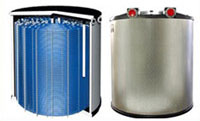Storing Wind Power as Ice?
 Of the total amount of electricity generated by all sources, about 75% is used by buildings, a major fraction of which is consumed by air conditioners. With the demand of renewable energy increasing with every passing day, inventors are trying to find the best possible means to store the generated energy during the best time, to provide power when the generators aren’t getting the resources they need. It is a natural phenomenon that the wind blows stronger at night than in the day. We don’t need that extra energy during nighttime. We can store this energy and use it during daytime when the load is too much on the grid.
Of the total amount of electricity generated by all sources, about 75% is used by buildings, a major fraction of which is consumed by air conditioners. With the demand of renewable energy increasing with every passing day, inventors are trying to find the best possible means to store the generated energy during the best time, to provide power when the generators aren’t getting the resources they need. It is a natural phenomenon that the wind blows stronger at night than in the day. We don’t need that extra energy during nighttime. We can store this energy and use it during daytime when the load is too much on the grid.When we utilize alternative sources of energy, how to store the energy poses a big problem. Scientists often create giant sized batteries or compressed air and hydroelectric storage. But now a company, Calmac Booth is thinking of storing extra power in ice!
Air conditioning in the summer consumes the lion’s share of a building’s energy cost. Calmac Booth is manufacturing a hybrid cooling system. This system exploits an ice bank thermal energy storage tank known as IceBank. IceBank makes and stores ice for use in air conditioning systems when the wind is blowing a bit faster or the sun isn’t shining, that is, at night.
Heavily insulated polyethylene is used to manufacture the IceBank tanks. They also contain a spiral-wound, polyethylene-tube heat exchanger surrounded with water. The tanks are available in a variety of sizes. According to one’s need it is available from 45 to over 500 ton-hours. When the charging cycle is going on, a solution containing 25% ethylene or propylene glycol is cooled by a chiller. In the next step this solution is circulated through the heat exchanger inside the IceBank tank. It has to be noted that the ethylene-based or propylene-based is an industrial coolant. These coolants are particularly devised for low viscosity and superior heat-transfer properties.
The unique property of the IcaBank is that the ice is built uniformly throughout the tank. Charging cycle of an IceBank tank takes about 6 to 12 hours. This device can also be utilized in conjunction with a solar panel array.
During summer time the entire system tries to survive during peak hours. IceBank simply prepares ice at night, when electricity is cheaper and it is cooler. During afternoon, this stored energy can be consumed by running air conditioning. At that time it is hot and electricity is in short supply. IceBank can help in reducing the load on the grids during peak hours. According to the company reducing electricity demand for cooling can cut energy costs by 20 - 40 percent. That reduction also translates into fewer emissions from power plants.
This system can be applicable to those buildings too which are without on-site renewable energy power generation. Ice can be prepared during night i.e. off-peak time. During off-peak, electricity is cheaper and cleaner baseload generation can be used. Calmac explains that for every kilowatt-hour of energy that is shifted from on-peak usage to off-peak, there is a decrease in the source fuel needed to generate it. This reduction can be between 8 and 30%.
You can return to the main Market News page, or press the Back button on your browser.

